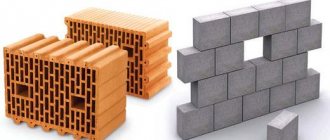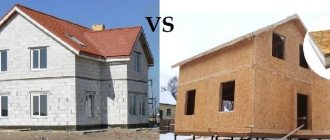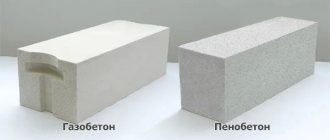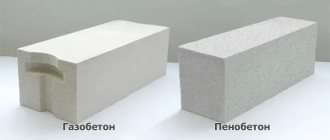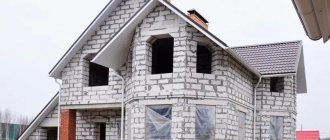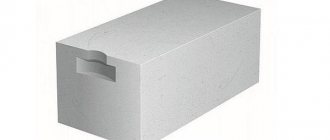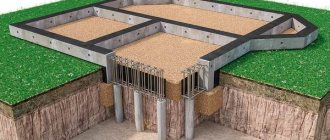What is more suitable for building the walls of a house, ceramic block or aerated concrete - the opinions of experts on this issue are not clear. Both building materials have the same popularity and similar properties. Let's look at their main advantages and disadvantages, what operational characteristics they have, what parameters are similar and what diverge, what are the main selection criteria, as well as what are the features of the masonry technology of both.
Gas blocks vs warm ceramic modules Source ytimg.com
Characteristics of ceramic blocks
When resolving the dilemma of what is more suitable for building a house - ceramics or aerated concrete, many choose the first option. Let's look at why this happens - what are the main parameters, pros and cons of this material.
Material parameters
Ceramic blocks are rectangular modules of a microporous structure with cavities inside. They are made by molding a clay mixture and then firing it. In this case, voids are formed due to the inclusion in the mass of the workpiece of special elements from the material that burns out during heat treatment.
General characteristics of clay modules:
- High thermal insulation rates - thanks to the microporosity of the structure.
- The dimensions are several times larger than those of standard bricks. At the same time, similar raw materials are used as a basis.
- Half of the hollow volume in the structure, which significantly reduces their thermal conductivity and improves the heat conservation of the room.
- Ability to withstand up to fifty freezing-thawing cycles.
- Wide variety of sizes.
- Strength indicator – 75 points.
- The presence of side grooves for better fastening in the masonry and corrugation on the outer and inner sides for applying plaster.
Structure of a ceramic block Source lesstroy.net
Ceramic blocks can differ in the following number of characteristics:
- Position relative to the structure of the wall - ordinary and front.
- The type of surface texture is smooth and textured.
- The presence of coloring pigments.
- The presence of voids – solid and hollow
- Geometry of cavities.
- Presence of holes for easy installation.
Helpful information! So that the consumer knows how much a particular block exceeds a standard brick in terms of volume, manufacturers introduced the designation NF. For example, if a ceramic block has a value of 10NF, this means that it holds 10 ordinary bricks.
Advantages and disadvantages
Among the obvious advantages of clay blocks are the following:
- Minimum weight with impressive dimensions and a large margin of safety. This allows you to reduce the cost of building a strong foundation.
- Quick installation – facilitated by the large size of the modules.
- Saving on masonry mixture - the grooves connected on the side surfaces do not need to be filled with mortar.
- Long service life - with proper installation it can last up to 50 years.
Durable house made of ceramic blocks Source stroitelstvo-74.ru
- High sound insulation parameters.
- Safety of the material for humans and the environment. The composition includes an environmentally friendly sand-clay mixture.
- Maximum resistance to combustion processes.
- Minimum thermal conductivity (thanks to micropores, cavities and tongue-and-groove seams), which allows you to save on heating in winter and provide a cool microclimate in hot weather.
- Moisture resistance not exceeding 10%.
- Possibility of choosing modules in sizes suitable for any project.
- Thermal inertia is the ability to retain heat for a long time in the absence of its source.
- High aesthetic properties, which allows the building to be used without finishing.
- Resistance to various atmospheric conditions - rain, snow, wind, etc.
The disadvantages of the material include:
- High price.
- The need to follow the manufacturer's recommendations during installation - use masonry adhesive, construction mesh for each row, etc.
- The difference in the height of the blocks can reach almost 0.5 cm, which significantly increases the consumption of the masonry mixture.
Varieties of warm ceramic modules Source housevrn.ru
- There is a high probability of purchasing material that does not meet GOST requirements. There are many private companies on the market, but only certified manufacturers can have certified characteristics.
- The porosity of the structure promotes moisture saturation. Therefore, additional moisture insulation is required.
- Low machinability - drilling, chipping and other procedures must be carried out with special tools using special technology.
- Need to be careful during transportation.
Note! When laying modules, it is recommended to use special glue from the manufacturer. In this case, the voids must be covered with a fine construction mesh before applying it.
See also: Catalog of companies that specialize in the construction of houses made of aerated concrete and ceramic blocks
Which material is better in terms of budget at home?
Every private developer strives for the economical use of resources for construction. Therefore, when comparing materials, it is worth considering what is more profitable to build a house from, aerated concrete or ceramic block.
To get an answer, you will have to calculate the estimated cost of the different stages of construction:
- The cost of masonry is approximately the same. Although in practice, masonry from expensive ceramic blocks in one layer (without external cladding) will cost more. Builders charge a high price for work that requires maximum precision and accuracy. For a house of 200 sq. m, the difference can be 15 thousand rubles, or approximately 0.25% of the total cost of construction.
- If you want to save money, you can choose aerated concrete or ceramic block from the cheapest segment. But the characteristics of such building materials may not correspond to the expected qualities.
- A significant expense in the construction budget is plastering the walls. More precise geometry of aerated concrete blocks allows saving on the thickness of the plaster layer. The difference for a house with an area of 200 sq. m will be 30–40 thousand rubles.
- If we take into account heating costs, aerated concrete houses are still the leaders in terms of efficiency compared to ceramic ones.
Judging by the calculations, the option of building a house from aerated concrete blocks seems more economical.
Features of gas blocks
In searching for an answer to the question of which is better, warm ceramics or aerated concrete, it is also necessary to analyze in detail the properties, pros and cons of the second option.
Material structure
In fact, aerated concrete is a frozen porous mass of sand-cement mortar with special components. It can be produced in two ways:
- Synthetic hardening (using an autoclave).
- Hydration setting (without using an autoclave).
Aerated concrete blocks Source beton-house.com
The porosity of the material is caused by the mixing of components that react with each other - aluminum in the form of powder and potassium hydroxide. As a result, bubbles of hydrogen gas are formed. To ensure uniform distribution in the mass, the solution is subjected to vibration. Then the frozen workpiece is sawn into blocks of the required dimensions.
Then, depending on the chosen method, they either gain strength on their own, or in a special chamber under pressure and elevated temperature - in an autoclave. Products obtained using the latter method have better strength, durability and durability. In addition, the set of characteristics required for construction occurs faster.
The density of aerated concrete varies widely - depending on it, products for various purposes are obtained:
- With improved thermal insulation properties.
With a density of no more than 400 kg/m3, the material has maximum heat-saving properties. However, it is not able to withstand any load other than its own weight.
Construction made from aerated blocks Source buildup.ru
- Mixed type.
The mass density varies from 500 to 800 kg/m3. It has sufficient strength for the construction of capital and interior walls.
- High strength.
The density indicator reaches the limit values - 1200 kg/m3. The material is suitable for the construction of strong load-bearing high structures, but will require insulation in the future.
In addition to the main components (cement, sand, water), aerated concrete blocks may contain other components - slag, lime, ash. Moreover, their share in volume can reach half.
Important! The magnitude of the deviation of dimensions from the norm determines the category of the aerated concrete module. So, with its value of 1.5 mm, the product belongs to the 1st category, from 2 to 3 mm - to the 2nd, and 4 mm - to the 3rd. Moreover, the greater the unevenness, the more masonry mortar is consumed and the larger the cooling zone.
Geometry of aerated concrete blocks Source k-oo.top
Which house is safer?
If a comparison of characteristics still does not answer the question of which material is better - warm ceramics or aerated concrete blocks, it is worth considering the safety criterion. Studies have shown that both materials are environmentally friendly and do not pose a threat. There are several explanations for this:
- both building materials are not a favorable environment for the proliferation of harmful organisms, so the likelihood of colonies of fungi (mold) that are hazardous to health appearing on the walls is extremely low;
- both materials are resistant to open flames;
- aerated concrete and warm ceramics are made from organic components with the addition of harmless synthetic compounds, so they do not create background radiation, toxic fumes, or other harmful influences.
Thus, buildings built from aerated concrete or ceramic blocks are equally safe. In addition, these building materials are quite durable. Ceramic options can withstand the loads in the structure of a 9-story building, and the load-bearing capacity of aerated concrete is enough for 5 floors. This means that both types of building materials are suitable for private construction.
Comparison of gas and ceramic blocks
Aerated concrete or ceramic blocks - which is better, allows you to understand the following list of comparisons of their properties:
- Installation speed.
Aerated concrete - large dimensions speed up the laying.
Ceramic block is poorly processed and, if necessary, difficult to adjust to the required dimensions.
- Thermal insulation.
Aerated concrete - the indicator may vary depending on the factory inclinations.
Ceramic block has a higher density and poorer thermal insulation.
- Strength.
Aerated concrete – does not exceed M50.
Ceramic block - reaches a value of M150.
- Wall mount.
Aerated concrete - can withstand loads of up to 300 kg.
Ceramic block - capable of withstanding forces of up to 500 kg.
Fastening elements for walls made of porous materials Source stroysoveti.ru
- Safety.
Aerated concrete - artificial components are added.
Ceramic block is a completely natural material.
- Dimensional accuracy.
Aerated concrete - discrepancies do not usually exceed 2 mm.
Ceramic block - deviations reach 6 mm.
- Microclimate.
Aerated concrete quickly becomes damp and does not release moisture well.
Ceramic block absorbs and releases moisture into the air well, keeping microclimate parameters as stable as possible.
- Price.
Aerated concrete is medium and inexpensive.
Ceramic block - above average.
- Manufacturing technology.
Aerated concrete is a non-autoclave grade that can be easily produced at home.
Ceramic block is complex, accessible only to specialized production.
Interesting information! Consumers who want to furnish their homes exclusively from natural materials need to know that ceramics consists only of clay and sand. Lime, quartz, aluminum powder, and cement are added to aerated concrete blocks during production. Such material does not fall within the framework of the purely natural.
Wall made of ceramic blocks Source ytimg.com
Durability
- The history of gas silicate construction tells us that after 15-20 years, the external walls shrink by about 2 mm. This may negatively affect the integrity of the masonry. We have known this material for 40 years; it is not yet possible to assess reliability beyond this period.
- The ceramic block appeared much earlier; we can already celebrate its 100th anniversary. But if we look deep into the history of buildings made of ceramic material, we can see today buildings with a 20-century history. In the photo, one of these buildings is the Anno Hotel (Lübeck, Germany), the first mention of which dates back to 1305.
Selection options
Aerated block or ceramic block – which is better to choose, the following list of criteria allows you to understand:
- Number of floors.
- Climatic conditions.
- Urgency of construction.
- Labor and processing time.
- Saving on heating.
- Rejection.
- Levelness of the base.
- Project cost.
It is ultimately up to the customer to decide which material will be chosen. However, it is better for him to listen to the opinion of experts. The durability of the house, its resistance to factors of destruction and the comfort of living in it will depend on this.
Features of installation technology
The main disadvantage of using aerated concrete blocks as part of a wall is the reduction in strength due to the inevitable processes of destruction of silicate structures. Therefore, a structure based on it must be reinforced. To do this, reinforcing elements are laid in every 3rd row, as well as in places of increased load, window and door openings, or simply in walls over 6 m long.
Warm ceramic blocks are not subject to this effect. In addition, they are so strong that they can be used to build houses of several floors completely without reinforcement. In construction practice, there are known cases of the construction of similar objects 10 floors high.
Aerated concrete or brick?
Estimate the square footage of the planned house, the period of its construction and finishing. Assess your financial condition and your ability to carry out construction work. Don't forget about the climatic features of the area. Simplified comparative characteristics to help:
- An aerated block weighs 3 times heavier than a brick.
- A gas-block house is built many times faster than a brick one.
- Brick is more expensive than gas block.
- Houses made of brick have been built for 500 years, and houses made of aerated block have been built only for the last 80.
- Aerated block is warmer than brick.
- The load-bearing capacity of a brick is higher than that of a gas block.
- The frost resistance of aerated concrete blocks is 50 cycles, and that of bricks is 75-100.
Briefly about the main thing
When looking for a solution to the question of which material to give preference to - gas blocks or warm ceramics, it is necessary to take into account the characteristics of each material separately and in comparison with each other. The most characteristic aspects of the analysis of their properties are:
- Ceramic blocks are made from clay and sand, gas blocks include cement, aluminum, lime, slag and other components.
- Both materials are porous. This makes them good thermal insulators. However, they absorb moisture well.
- The strength of the products is quite high, but aerated concrete modules when constructing structures of several floors require mandatory reinforcement.
- Aerated blocks are easier to process and cheaper than ceramic modules.
When choosing a material, you need to consider how it will behave in specific terrain and climate conditions. In this case, you need to rely not only on your knowledge of the issue, but also the opinion of experts in this field.
conclusions
A comparison of building blocks made of aerated concrete and ceramics showed that both technologies have a right to exist and are popular among developers. As experts rightly note, if one of the technologies had significant advantages, the second would simply be forced out of the construction market.
The result depends not only on the choice of material, but also on the competent preparation of the project, strict adherence to construction technologies and the installation of communications. Only if these conditions are met is it possible to build high-quality, durable housing.

